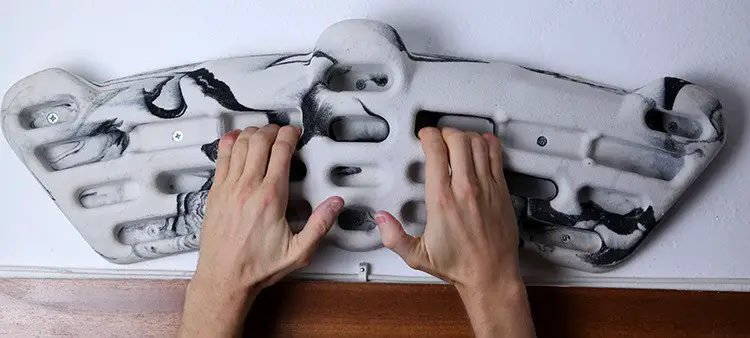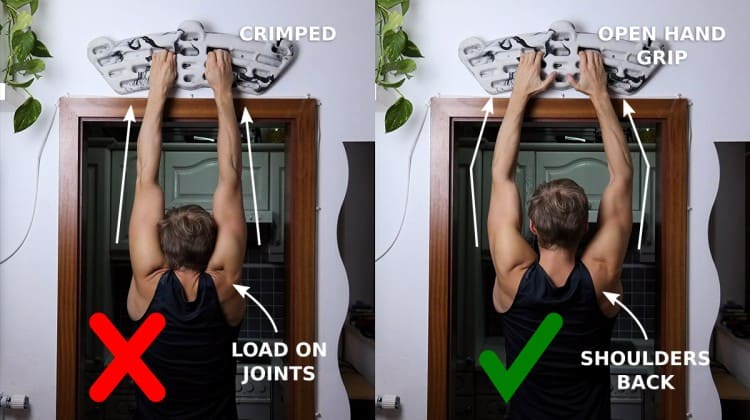A hangboard workout two or three times a week is one of the most effective ways of building up strength in your fingers. It’s a must for climbers, boulderer, and Ninja Warriors who want to gain excellent grip strength within the shortest time.
Increased strength also results in less fatigue over time, which will give your physical performance a major boost.
As you need nothing more than a hangboard and a little space to mount it, it’s perfect for training at home. Some athletes even say it’s the single most important training equipment they own.
So, if you want to get the maximum out of hangboarding and reduce the risk of injury at the same time, then this article is for you!
Why hangboard training is essential
For climbers, this question may be obsolete. But why is hangboard training so beneficial for Ninja Warriors? Let me answer this with a counterquestion: Have you ever seen the Cliffhanger obstacle of the Ninja Warrior competition, where wooden or plastic strips are mounted on a vertical wall with some overhang?
If you have already trained on that obstacle, you know that you won’t get far without strong fingers. Most of the time, your entire body weight lies on the first two phalanges. Often only on one hand. The Cliffhanger is by far the obstacle that puts the most stress on your fingers. But with a steady hangboard workout you will be perfectly prepared! And not only for that obstacle.
The video below shows me climbing the Cliffhanger in 2018. A year ago, before I started bouldering and training on the hangboard, that would have been an impossible challenge.
The basics of hangboard training
When training on the hangboard, aka fingerboard, you are basically doing isometric dead hangs from small holds. A dead hang is a static exercise where you hang with both hands on the board, and your feet are lifted from the ground. Each hand is on the same height and the same type of hold.
A good hangboard has typically various grip positions you can choose from. You can use the large grips for pull-up training and the smaller ones for strengthening your fingers.

The following exercises are possible on most hangboards:
- Open hand
- Crimp
- Pinch
- Three-finger pocket
- Two-finger pocket
- Sloper
Hangboard training exerts a lot of stress on tendons and the small muscles in your hands, but also on the arms and shoulders. The right mounting of the hangboard, a correct execution, a good warm up, and a limited amount of workouts per week are therefore crucial for preventing injuries.
Proper hangboard mounting
You should be able to lower your feet to the ground easily after each dead hang. Dropping to the floor can result in an injury of your finger tendons. So, mount the hangboard appropriately.
Correct execution
The right body posture is mandatory for keeping your shoulders healthy. Maintain moderate tension throughout your shoulders and upper torso by pulling your shoulder blades down and back. Also, bend your arms slightly while hanging.
Do not relax your shoulders and let them hang in a shrug position near your ears! This would put a lot of load on your joints. If you are currently not able to hold your shoulder blades long enough in the correct position, you can train the involved muscles on a pull-up bar by doing hanging shrugs, or so-called scapular pull-ups. Check out How to Train Pull-Ups like a Ninja Warrior for further details about hanging shrugs.
Finally, hang with an open hand, but don’t crimp. Injuries of your tendons are less likely by doing hangs like that. After a few weeks of training, you may also add the half crimp to your exercises.


Warm up and stretching
Do a warm-up of at least 15 min before each workout.
- Elevate your heart rate and warm up your muscles by doing light exercises such as jumping jacks or jogging in the beginning.
- Then stretch your upper body and do some self-massage of your fingers and forearms. This will enhance blood flow and loosen your muscles further.
- End your warm up with a few pull-ups on a pull-up bar or the large holds of the hangboard.
Once you have got your blood flowing, you are ready to go.
Adequate training amount and resting
Intensive hangboard workouts should be limited to two or three times a week. If you climb regularly, two times per week is even better to avoid finger and shoulder injuries.
Never overdo it and advance too fast! There are often no warning signs for many finger injuries.
Also remember, that training makes you weak at first. The following rest makes you strong and lets your body adapt to the heavy loads during the previous training. So rest a lot between hangboard workouts. I would recommend two full days.
The hangboard workout routine
To get the most out of your hangboard workouts, you should follow proven training programs with progressive overload. Otherwise, you will limit your gains or might get injured.
A popular way to train on the hangboard is the Repeaters protocol, which is a series of high-intensity hangs for gaining strength.
Beginner’s Repeaters protocol
In the beginning, it’s better to choose easier holds, where you can hang longer. This way, the load on your tendons and muscles is reduced.
- Choose 3 to 5 different grip positions and begin with the most challenging one.
- Perform 5 hangs on the first grip for 5 to 10 seconds.
- Rest for 5 to 10 seconds in between each hang.
- After one full set of repeaters for that grip position rest for 3 minutes. Do light stretching and massage your hands and arms during that break.
- Move on the next, less challenging grip position and repeat the process.
Advanced Repeaters protocol for maximum strength
After training for a few weeks, you can increase the number of sets, choose smaller holds and reduce the hang time.
- Choose 3 to 10 different grip positions and begin with the most challenging one.
- Perform 10 hangs on the first grip for 3 to 7 seconds.
- Rest for 3 to 7 seconds in between each hang.
- After one full set of repeaters for that grip position rest for 3 minutes. Do light stretching and massage your hands and arms during that break.
- Move on the next, less challenging grip position and repeat the process.
If you can easily hang for more than the maximum time on a specific hold, then use smaller holds or add some weight with a weight belt or vest. You can also use a climbing harness and hang free weights from the belay loop.
Endurance vs. strength training
In general, it’s best to perform shorter, more intense hangs for strength and longer, less intense hangs for endurance.
For endurance training, you can increase the hang and rest time to more than 20 seconds. Use larger, less intense holds and less weight, if you were already training with an additional load.
Training progression
Your body adapts to stimuli over time. So, if you want to keep getting stronger, you have to increase the stimulus steadily. You can do this by
- increasing your weight and the load on your fingers,
- decreasing the size of the holds or number of fingers used.
Keep in mind, that your body also needs time to adapt. Don’t advance to fast. Otherwise, injuries are likely to occur. It’s also beneficial to train the antagonists by doing some finger stretch training.
Apps for timing your hangboard workout
There are several great Android apps for timing the workout. You can set hang, pause, and rest time and adjust the number of hangs and sets. Some of them also have a workout log.
Which hangboard to choose
The hangboard you choose is as important as the training protocol you are following and the proper execution of your workout. Here is my favorite hangboard which I love to recommend:
If you want to know how I chose this hangboard and what awesome alternatives are on the market, check out the following article:
Conclusion
Hangboard training is a great way to improve strength in your fingers and give you a massive boost in your physical performance during climbing and Ninja Warrior training!
So, give it a try! Start training your fingers with a hangboard and experience that boost in strength.
One last word of advice: Listen to your body to prevent finger or shoulder injuries. If you feel pain, your fingers become sore, and you can’t finish a set, pause for a few days and let your body regenerate. Also, limit your hangboard training to two or three times a week to keep your fingers intact.
I hope you enjoyed this article. Let me know by sharing it or commenting below. I would highly appreciate that!
Want to Take Your Pull-Ups to a Whole New Level?
Just join the newsletter below and get a free copy of my pull-up performance guide with 16 powerful tips.